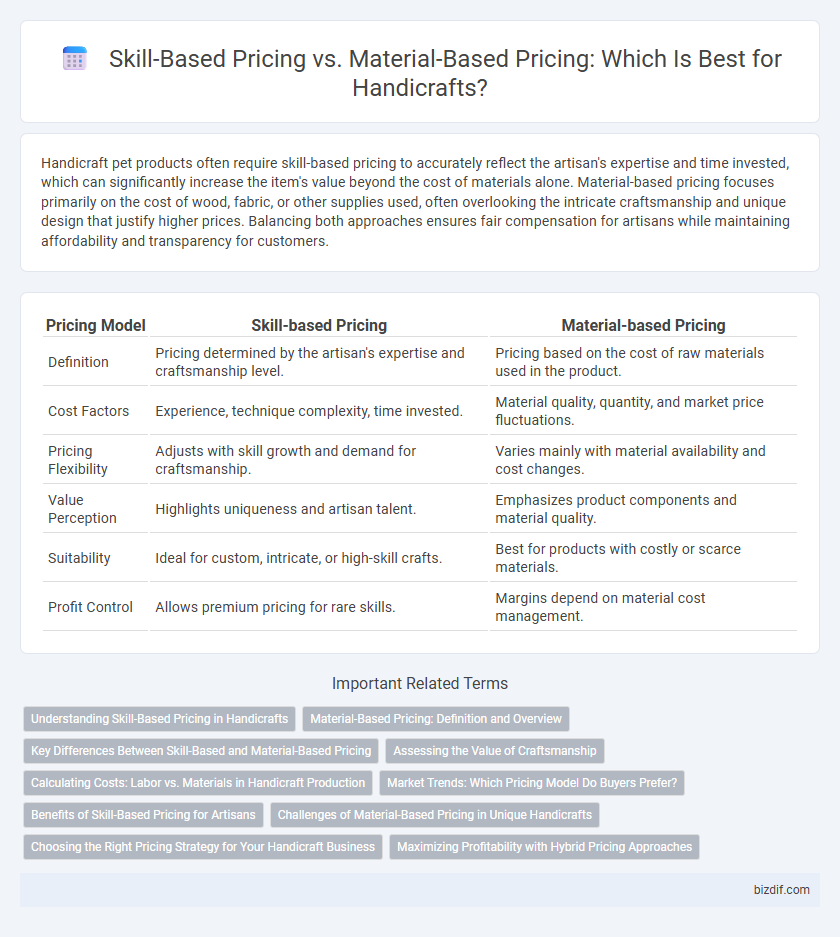Handicraft pet products often require skill-based pricing to accurately reflect the artisan's expertise and time invested, which can significantly increase the item's value beyond the cost of materials alone. Material-based pricing focuses primarily on the cost of wood, fabric, or other supplies used, often overlooking the intricate craftsmanship and unique design that justify higher prices. Balancing both approaches ensures fair compensation for artisans while maintaining affordability and transparency for customers.
Table of Comparison
| Pricing Model | Skill-based Pricing | Material-based Pricing |
|---|---|---|
| Definition | Pricing determined by the artisan's expertise and craftsmanship level. | Pricing based on the cost of raw materials used in the product. |
| Cost Factors | Experience, technique complexity, time invested. | Material quality, quantity, and market price fluctuations. |
| Pricing Flexibility | Adjusts with skill growth and demand for craftsmanship. | Varies mainly with material availability and cost changes. |
| Value Perception | Highlights uniqueness and artisan talent. | Emphasizes product components and material quality. |
| Suitability | Ideal for custom, intricate, or high-skill crafts. | Best for products with costly or scarce materials. |
| Profit Control | Allows premium pricing for rare skills. | Margins depend on material cost management. |
Understanding Skill-Based Pricing in Handicrafts
Skill-based pricing in handicrafts emphasizes the artisan's expertise, time, and unique techniques, reflecting the true value of handcrafted items beyond raw material costs. This approach accounts for craftsmanship complexity, artistic creativity, and the rarity of skills involved, often leading to higher price points compared to material-based pricing. Recognizing the specialized labor and mastery required ensures fair compensation and preserves traditional artisanal heritage.
Material-Based Pricing: Definition and Overview
Material-based pricing in handicrafts involves calculating the cost of raw materials used to create an item, ensuring that pricing reflects the quality and expense of essential components like wood, fabric, or metal. This method emphasizes transparency and cost recovery, which is crucial for artisans working with costly or rare materials. Material-based pricing helps establish a baseline value, allowing craftsmen to fairly charge for tangible inputs in their creative process.
Key Differences Between Skill-Based and Material-Based Pricing
Skill-based pricing in handicrafts emphasizes the artisan's expertise, craftsmanship, and time invested, reflecting the unique value of the handmade work. Material-based pricing calculates costs primarily on raw materials and production expenses, often undervaluing the creative process and specialized skills. The key difference lies in valuing intangible expertise versus tangible resources, impacting how artisans price their products and communicate worth to customers.
Assessing the Value of Craftsmanship
Skill-based pricing emphasizes the artisan's expertise, creativity, and time invested in creating unique handicrafts, often leading to higher perceived value and customer willingness to pay. Material-based pricing focuses on the cost of raw materials, which can undervalue the intricate craftsmanship and emotional connection embedded in handmade products. Assessing the value of craftsmanship requires balancing labor intensity and artistic skill with material expenses to fairly represent the true worth of handicrafts.
Calculating Costs: Labor vs. Materials in Handicraft Production
Skill-based pricing in handicraft production emphasizes the value of labor by accounting for the artisan's expertise, craftsmanship time, and unique techniques, often leading to higher price points. Material-based pricing focuses primarily on the cost of raw materials like wood, fabric, or metal, which can fluctuate but may undervalue the artisan's effort. Accurately calculating costs requires balancing both labor intensity and material expenses to reflect true production value and ensure sustainable pricing.
Market Trends: Which Pricing Model Do Buyers Prefer?
Market trends indicate a growing preference for skill-based pricing in handicrafts, as buyers increasingly value artisanal expertise and unique craftsmanship over mere material costs. Data from consumer surveys reveal that 68% of buyers are willing to pay a premium for handcrafted products that showcase specialized skills, reflecting a shift towards valuing authenticity and artistic effort. Material-based pricing remains relevant for standardized goods, but the market favors pricing models that highlight the creator's talent and time invested.
Benefits of Skill-Based Pricing for Artisans
Skill-based pricing empowers artisans by directly valuing their craftsmanship, creativity, and expertise, leading to fairer compensation that reflects the true effort and mastery involved. This pricing model encourages continuous skill development and fosters innovation, enhancing the overall quality and uniqueness of handmade products. Artisans benefit from greater financial independence and motivation, which can elevate their market reputation and customer loyalty.
Challenges of Material-Based Pricing in Unique Handicrafts
Material-based pricing in unique handicrafts often underestimates the true value of intricate craftsmanship and the artisan's expertise, leading to potential financial losses for creators. The variability of raw materials' costs coupled with the time-intensive nature of handcrafting processes makes consistent pricing difficult. This approach also fails to capture the emotional and cultural significance embedded in each piece, limiting market appreciation and fair compensation.
Choosing the Right Pricing Strategy for Your Handicraft Business
Skill-based pricing emphasizes the value of artisans' expertise and craftsmanship, allowing premium charges for intricate handiwork and unique designs. Material-based pricing focuses on the cost of raw materials, ensuring pricing covers expenses but may undervalue the artisan's skill. Selecting the right pricing strategy requires balancing labor intensity and material costs to maximize profitability and reflect the true worth of handcrafted products.
Maximizing Profitability with Hybrid Pricing Approaches
Skill-based pricing leverages the artisan's expertise, ensuring compensation reflects craftsmanship complexity and time investment. Material-based pricing accounts for raw costs, securing baseline financial coverage and transparency. Combining these approaches in hybrid pricing optimizes profitability by balancing resource expenses with the intrinsic value of artisanal skill, enhancing market competitiveness and revenue potential.
Skill-based Pricing vs Material-based Pricing Infographic

 bizdif.com
bizdif.com